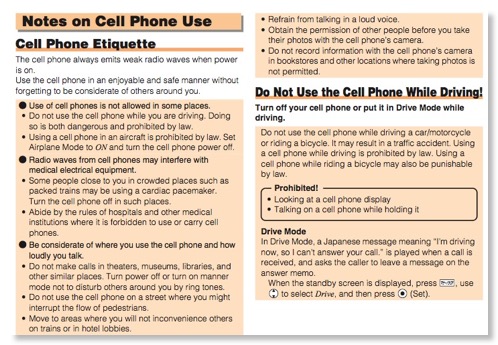Observations on Cell Phone Carrier Policies Overseas
Having recently rented a cellphone in Japan and bought GSM SIM cards in France and UK for my cheap unblocked cellphone reserved for overseas use, one thing all 3 transactions had in common: personal identification was required.
The US is the outlier in the industrialized countries in allowing purchase and use of cellphones in general without any identification, a topic of recurring discussion here. While there are major societal reasons against imposing a strict identification requirement on all cellphone sales in the US at the moment, the unrestricted sale of bagfuls of prepaid cellphones at Walmart and other large retailers should raise some real questions. Anonymous prepaid cellphones are widely used in criminal acts as the communications media of choice and are feeding the contraband prison cellphone use problem.
While I sincerely hope that the US never has a cellphone-activated IED terrorist incident, the unrestricted availability of anonymous cellphones is a real risk factor.
We have previously written about the Japanese “manner mode”, an easy consistent way to silence all cell phones in Japan - by comparison there is no consistent way to silence all US market cell phones and the root cause of the Marimba/Mahler incident was that the user thought he had silenced the phone but had not realized that silencing all alarm modes was an extra step.
While discussing “manner mode” with a Japanese friend, he mentioned that Japanese cell phones also have “drive mode”. Curious, I Googled for an English manual for a Japanese cell phone and found one from KDDI, a major Japanese cellular carrier:

Note the following points that you would never hear from a US carrier:
- Do not use the cell phone while driving
- Be considerate of where you use the cell phone and how loudly you talk.
- Do not make calls in theaters, museums, libraries, and other similar places. Turn off power or turn on manner mode not to disturb others around you by ring tones.
- Do not use the cell phone on a street where you might interrupt the flow of pedestrians.
- Move to area where you will not inconvenience others on trains or in hotel lobbies.
- Refrain from talking in a loud voice.
- Turn off your cell phone or put it in Drive Mode while driving,
While not all readers would agree with all the suggestions in the KDDI manual, I hope many will agree that the US cell phone industry should try some of these ideas to reduce the social friction from today’s cell phone use.
Late in my travels I visited France where I purchased a SIM card from SFR - a major carrier for my minimalist GSM unblocked phone (purchased in Singapore several years ago for about $20). I received with the SIM card a copy of “Mon Mobile et Ma Santé” (My cellphone and my health), a flyer from la Fédération Française des Télécoms, the French trade association of both wireless and wireline carriers, effectively the CTIA counterpart. The content of the brochure is basically the text of the FFT cellphone/health web page. Included is the following text:
Il est conseillé aux femmes enceintes d’éloigner le téléphone du ventre et aux adolescents de l’éloigner du bas ventre.
Without formal qualifications as a French translator (and open to feedback on this topic), let me translate this as
It is advisable for pregnant women to keep mobile phones away from the abdomen and teens away from the lower abdomen.
The brochure also advises costumers to use the cellphone to preferably in areas of good reception since the cell phone reduces transmit power automatically in such places and thus reduces your exposure to radiation. It adds that that is places where the reception is 4-5 bars the phone’s transmissions are weakest and so is your exposure to RF.
The FFT website, but not the brochure they publish, advises
Which I translate asL’utilisateur peut aussi choisir un modèle de téléphone mobile à faible DAS, ce qui lui permet de réduire le niveau maximal de son exposition aux ondes radio.”
The user can also select a phone model low SAR, which reduces the maximum level of exposure to radio waves.
Readers may recall that this point is in contention in the ongoing CTIA/San Francisco litigation and is a point strongly disputed by the US cell phone industry.
I hope readers in the US market will find these observations of foreign cellphone markets thought provoking and starting asking questions about whether US carriers should adopt some of the policies in use in other countries.



![Validate my RSS feed [Valid RSS]](valid-rss-rogers.png)

